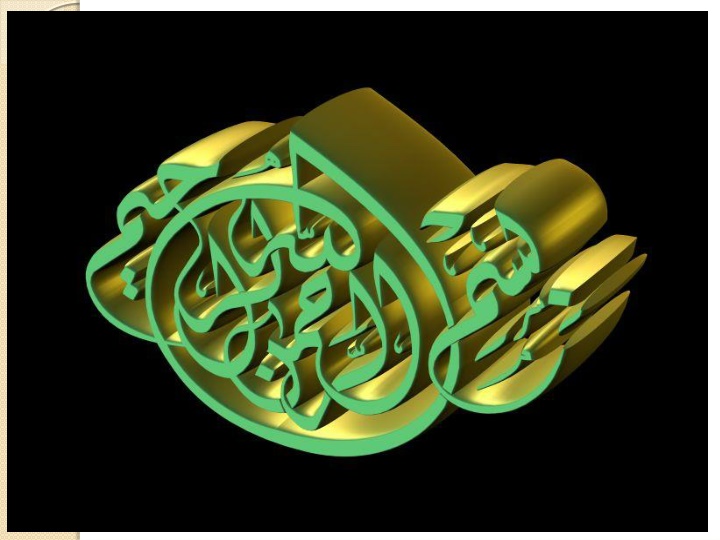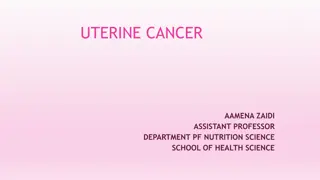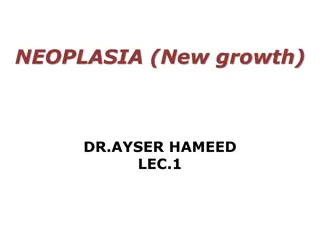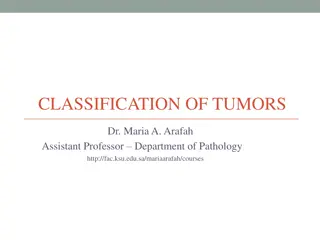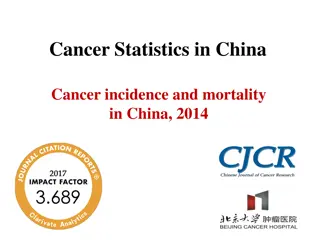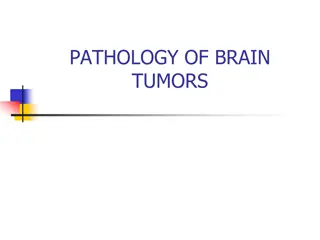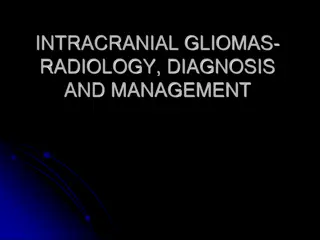Etiology of Tumors and Cancer Incidence
Etiology of tumors covers the genetic predisposition, precancerous conditions, and carcinogenesis concepts. Understand cancer incidence variation with age, race, and environmental factors like geographic disparities. Environmental factors such as smoking and alcohol are key influences. The impact of age on cancer frequency, especially in children, is also discussed.
Download Presentation

Please find below an Image/Link to download the presentation.
The content on the website is provided AS IS for your information and personal use only. It may not be sold, licensed, or shared on other websites without obtaining consent from the author.If you encounter any issues during the download, it is possible that the publisher has removed the file from their server.
You are allowed to download the files provided on this website for personal or commercial use, subject to the condition that they are used lawfully. All files are the property of their respective owners.
The content on the website is provided AS IS for your information and personal use only. It may not be sold, licensed, or shared on other websites without obtaining consent from the author.
E N D
Presentation Transcript
Experimental Experimental Embryology Embryology
Principals of Experimental Principals of Experimental Embryology Embryology
Lect.(4) Embryonic and Cancer Cells ( 4 ) 1- Introduction and Definition 2- Type of Cancer cells 3- Type of Cancer cell 4- Cancer Reasons 5- Cancer Theories 6- Similarities and differences between embryonic and cancer cells
Lect.(4) Embryonic and Cancer Cells ( 4 ) 1- Introduction and Definition At the beginning perhaps comes to mind a question: Why does this subject here in the experimental embryology ! It is known that cancer is the abnormal growth of cells in the tissues and organs of the body. The cancer cells did not come from abroad, but it is originally from the body and as a result of influences what (whether internal or external) has turned this healthy cells into cancer cells in the body; means that the cancer cells, originally cells were differentiated and then lost this differentiation, and also lost the control in the divisions properly.
As well as, embryonic stem cells are undifferentiated cells at the beginning and then differentiate and division properly. As we known from regeneration subject, the developing cells lose their differentiation and then return to the differentiation or trans differentiation for the amputee part. . Zoo 424 Lecture 4, Embryonic and cancer cells
2-Type of Cancer cells There are two types of cancer cells:1-normal tumors - 2 and2 Malignant tumors or cancer . 1- Normal tumors are not proper growth of the cells, but does not affect the place where it grows, also does not spread and its not difficult to control, for examples of the moles in the body. While 2- malignant tumor cells are not proper growth of cells, its affects different organs or tissue in the body and spread ,also difficult to control, such brain cancer, Lung and colon cancer
3- Cancer Cells names Depends on the layer cells that are derived from cancer cells Sarcoma : 1- : ( From mesoderm cells or connective tissues ) Carcinoma 2- : ( From the ectoderm cells (Epithelial cells) ) . From the melanocytes :Melanoma 3- . From the bone Leukemia 4- : marrow Teratoma 5- : From Primordial Germ-Cells- ( ) . PGCs
4- Causes of cancer There are many things believed to cause cancer, but can be summarized in three things as main reasons of the cancer, namely: 1-chemicals, 2- radiation, and 3-viruses. All these causes are involved in the way of their effect on the cells, these substances affect the chromosomes in the cells and affecting therefore the genes responsible for the control of cell division, then division uncontrolled and turn into cancer cells.
1- Chemicals * The chemicals that lead to cancer called Carcinogen, mean has carcinogenic effect * Chemicals reach to the body either through touch or during breathing or by mouth with food. * Chemicals listed in the following table, not for inventory but are examples and you can refer to the references and all bulletins from the Food organization, Cancer Society, fighting against smoking, Academy of Science in the New York and others. Zoo 424 Lecture 4, Embryonic and cancer cells
* Smoking Cadmium chlorid ) / Fuel gas Chloroform Naphthalin / / Nikel Finial ) ( / Ether
2- Radiation types and sources X-rays (X) for medical diagnosis, gamma rays, which were sometimes issued from some of the devices and radioactive chemicals, and ultraviolet radiation UV from the sun and some lighting sources, radiation from nuclear reactors and nuclear bombs. As was the case when the United States dropped the atomic bomb on Japan and the resulting damaging environmental effects on Japan and deformities of the embryos for several generations, as well as the leakage of radiation from Chernobyl in Russia, and his effects successor on human life and birth in the region that has spread there. When exposing the cells to sufficient doses of radiation, they turn to cancer cells. UV rays cause skin cancer and the atomic bombs caused blood cancer or leukemia.
3- Viruses Rous in (1911) discovered that the viruses caused the cancer, when isolated the virous and the carcenogenic virus was injected in the chickens which free from cancer, it is causes cancer for injected chickens. * The virus inject the genetic material (DNA, RNA) into the cell and it is linked with the genetic material of the injected cell. and may change the behavior and function of the cell and thereby creating a disable or change of certain properties within the cell and causes cell to become a cancer cell.
5- Cancer Theories There are three theories explain the cancer as follows: - - 5 1- Irritation Cancer Theory Chemicals and radiation causes irritation of cells , they - 1 lose the ability to control the normal cell proliferation, then they becomes cancer cells and divide in uncontrolled manners. 2- Embryonic Tumor Theory - 2 This theory states that there are cells in the body since the embryonic stage continue without differentiation, and then turn to cancer cells later, this theory is based on the similarities between stem cells and cancer cells.
3-Oncogene Theory A - This theory is closest to the acceptance, where assume that - 3 there are already tumor genes in cells, and these genes can be activated by carcinogens. Evidenced the validity of this theory when injected tumor genes isolated from cancer cells in healthy cells, they turned into cancer cells. B- Proto-Oncogene-Activation It is the normal genes are present in the cells, but in latent inactive images, and any alteration or change it stimulated genes, and turning it into a tumor genes, there are 40 proto oncogenes isolated as tumor genes that are found on chromosome No. 11,18. It can activate these genes, in experimental animals by any one of the following ways: -
Proto-Oncogene-Activation 1- Viruses Protooncogenes of tumor genes on chromosomes can be activated by some viruses. When tumor virus were injected inside the normal cells, it turning these cells into cancer cells. 2- Mutation Mutation can made by by chemical or carcinogen or radiation witch can led to activate the protooncogene 3-Amplification Repeated copies of the tumor genes makes normal cell turn into a cancer cell (See to next Fig..) Zoo 424 Lecture 4, Embryonic and cancer cells
* The reasons for the spread of cancer cells: 1- Increase the rate of division of cancer cells, which helps to disintegration 2- Changes in the surface of cancer cells, helping to circumvention of the immune system. 3- Rupture of the tissues and separation of cells from each other as a result of enzymatic secretions produced by cancer cells. 4- loss of Contact Inhibition property 5- Cell proliferation may be due to activate genes specific to that.
6- Similarities and differences between embryonic cells and cancer cells 1- original cells The origin of all embryonic cells and cancer cells is one the fertilized egg. But embryonic cells appear in the beginning and while cancer cells appear later. 2 - Reproduction and growth Embryonic cells continue in reproduction and growth and then differentiate, as well as cancer cells continue in reproduction and grow but without discipline, and even in cell cultures when the normal cells are crowded, they are stop, while cancer cells are continue.
Theoretical similarities between cancer process and ontogenetic development. Correspondence of steps and structures between the cancer process and embryo development. Zoo 424 Lecture 4, Embryonic and cancer cells
* AutoWarburg suggested that the increase in growth and reproduction due to the increase in the absorption of food and insertion of the food into the cells and all of this is due to the change in the permeability of the cell membrane. 3 - Cell migration and transfer Malignant cancer cells move from the place and spread in other tissues of the body such as cancer of skin cells (melanoma), cells migrate and settle in the lungs (Fig. 50). Also, some embryonic cells move from the place of composition and settle in other tissues such as the primary germ cells and neural crest cells. Zoo 424 Lecture 4, Embryonic and cancer cells
* . 4 - Cell surface and respiration * Cellular respiration process and glucose consume were increased in cancer and embryonic cells, where increase of the sugar analysis process (Glycolysis).
5- Differentiation Cellular differentiation is advantage to embryonic cells, and the removal of differentiation (dedifferentiation) occurs in some regeneration and cancer cells, and trans- differentiation as in iris and retinal cells transformation into the lens cells. Cancer cells can lose differentiation and trans- differentiation property. Culture of the cancer cell nucleus and place of oocyte nucleus, they are growing properly in the frog. When trnasfer the teratoma cells under the skin of mouse, they form tumors. But the transfer of cancer cells themselves in the Blastula stage, they grow properly and form embryos free from tumor and normal mice (look to next Fig.).
Fig.: When transfer the teratoma cells under the skin of mouse, they form tumors. But the transfer or injecting of cancer cells insid the Blastula stage, they grow properly and form embryos free from tumor and developed to normal mice.
